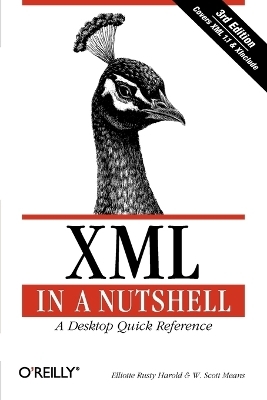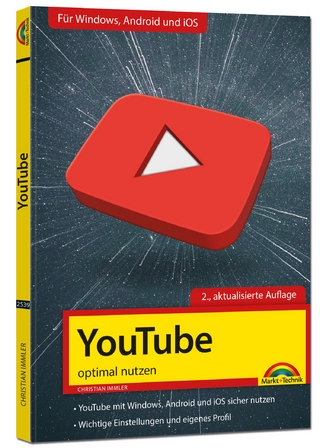
XML in a Nutshell
O'Reilly Media (Verlag)
978-0-596-00764-5 (ISBN)
If you're a developer working with XML, you know there's a lot to know about XML, and the XML space is evolving almost moment by moment. But you don't need to commit every XML syntax, API, or XSLT transformation to memory; you only need to know where to find it. And if it's a detail that has to do with XML or its companion standards, you'll find it--clear, concise, useful, and well-organized--in the updated third edition of XML in a Nutshell.
With XML in a Nutshell beside your keyboard, you'll be able to: * Quick-reference syntax rules and usage examples for the core XML technologies, including XML, DTDs, Xpath, XSLT, SAX, and DOM * Develop an understanding of well-formed XML, DTDs, namespaces, Unicode, and W3C XML Schema * Gain a working knowledge of key technologies used for narrative XML documents such as web pages, books, and articles technologies like XSLT, Xpath, Xlink, Xpointer, CSS, and XSL-FO * Build data-intensive XML applications * Understand the tools and APIs necessary to build data-intensive XML applications and process XML documents, including the event-based Simple API for XML (SAX2) and the tree-oriented Document Object Model (DOM) This powerful new edition is the comprehensive XML reference. Serious users of XML will find coverage on just about everything they need, from fundamental syntax rules, to details of DTD and XML Schema creation, to XSLT transformations, to APIs used for processing XML documents. XML in a Nutshell also covers XML 1.1, as well as updates to SAX2 and DOM Level 3 coverage.
If you need explanation of how a technology works, or just need to quickly find the precise syntax for a particular piece, XML in a Nutshell puts the information at your fingertips. Simply put, XML in a Nutshell is the critical, must-have reference for any XML developer.
Elliotte Rusty Harold is a noted writer and programmer, both on and off the Internet. He started by writing FAQ lists for the Macintosh newsgroups on Usenet, and has since branched out into books, web sites, and newsletters. He's currently fascinated by Java, which is beginning to consume his life. His Cafe Au Lait web site at http://sunsite.unc.edu/javafaq/ is a frequently visited Java site. Elliotte resides in New York City with his wife Beth and cat Possum. When not writing about Java, he enjoys genealogy, mathematics, and quantum mechanics, and has been known to try to incorporate these subjects into his computer books (when he can slip them past his editors). So far he hasn't been able to, but he suspects that a short, last-minute biography might not be inspected as closely as the rest of a manuscript. His previous book is Java Developer's Resource from Prentice Hall. W. Scott Means has been a professional software developer since 1988, when he joined Microsoft Corporation at the age of 17. He was one of the original developers of OS/2 1.1 and Windows NT, and did some of the early work on the Microsoft Network for the Advanced Technology and Business Development group. Most recently, he served as the CEO of Enterprise Web Machines, a South Carolina based Internet infrastructure venture. He is currently writing full-time and consulting on XML and Internet topics.
Preface; I. XML Concepts; 1. Introducing XML The Benefits of XML Portable Data How XML Works The Evolution of XML; 2. XML Fundamentals XML Documents and XML Files Elements, Tags, and Character Data Attributes XML Names References CDATA Sections Comments Processing Instructions The XML Declaration Checking Documents for Well-Formedness; 3. Document Type Definitions (DTDs) Validation Element Declarations Attribute Declarations General Entity Declarations External Parsed General Entities External Unparsed Entities and Notations Parameter Entities Conditional Inclusion Two DTD Examples Locating Standard DTDs; 4. Namespaces The Need for Namespaces Namespace Syntax How Parsers Handle Namespaces Namespaces and DTDs; 5. Internationalization Character-Set Metadata The Encoding Declaration Text Declarations XML-Defined Character Sets Unicode ISO Character Sets Platform-Dependent Character Sets Converting Between Character Sets The Default Character Set for XML Documents Character References xml:lang II. Narrative-like Documents; 6. XML as a Document Format SGML's Legacy Narrative Document Structures TEI DocBook OpenOffice WordprocessingML Document Permanence Transformation and Presentation; 7. XML on the Web XHTML Direct Display of XML in Browsers Authoring Compound Documents with Modular XHTML Prospects for Improved Web Search Methods; 8. XSL Transformations (XSLT) An Example Input Document xsl:stylesheet and xsl:transform Stylesheet Processors Templates and Template Rules Calculating the Value of an Element with xsl:value-of Applying Templates with xsl:apply-templates The Built-in Template Rules Modes Attribute Value Templates XSLT and Namespaces Other XSLT Elements; 9. XPath The Tree Structure of an XML Document Location Paths Compound Location Paths Predicates Unabbreviated Location Paths General XPath Expressions XPath Functions; 10. XLinks Simple Links Link Behavior Link Semantics Extended Links Linkbases DTDs for XLinks; 11. XPointers XPointers on URLs XPointers in Links Shorthand Pointers Child Sequences Namespaces Points Ranges; 12. XInclude The include Element Including Text Files Content Negotiation Fallbacks XPointers; 13. Cascading Style Sheets (CSS) The Levels of CSS CSS Syntax Associating Stylesheets with XML Documents Selectors The Display Property Pixels, Points, Picas, and Other Units of Length Font Properties Text Properties Colors; 14. XSL Formatting Objects (XSL-FO) XSL Formatting Objects The Structure of an XSL-FO Document Laying Out the Master Pages XSL-FO Properties Choosing Between CSS and XSL-FO; 15. Resource Directory Description Language (RDDL) What's at the End of a Namespace URL? RDDL Syntax Natures Purposes III. Record-like Documents; 16. XML as a Data Format Why Use XML for Data? Developing Record-Like XML Formats Sharing Your XML Format; 17. XML Schemas Overview Schema Basics Working with Namespaces Complex Types Empty Elements Simple Content Mixed Content Allowing Any Content Controlling Type Derivation; 18. Programming Models Common XML Pro
| Erscheint lt. Verlag | 2.11.2004 |
|---|---|
| Reihe/Serie | In a Nutshell (O'Reilly) |
| Verlagsort | Sebastopol |
| Sprache | englisch |
| Einbandart | Paperback |
| Themenwelt | Mathematik / Informatik ► Informatik ► Web / Internet |
| ISBN-10 | 0-596-00764-7 / 0596007647 |
| ISBN-13 | 978-0-596-00764-5 / 9780596007645 |
| Zustand | Neuware |
| Haben Sie eine Frage zum Produkt? |
aus dem Bereich


